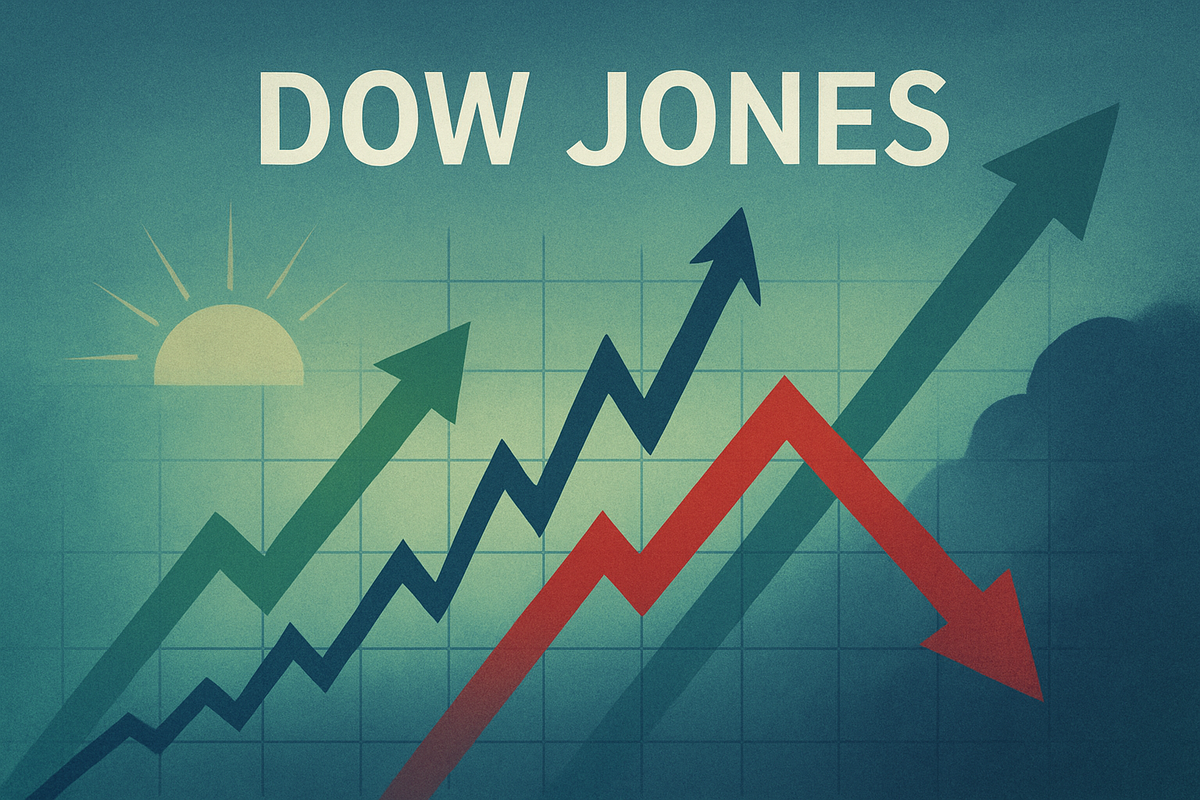Dow Jones Navigates Choppy Waters: Rate Cut Hopes Clash with Valuation Fears

The Dow Jones Industrial Average (DJIA) has recently been a barometer of a market caught between conflicting forces, demonstrating significant daily fluctuations throughout November 2025. While the venerable index has managed to maintain positive year-to-date performance, its recent movements underscore a pervasive sentiment of uncertainty, where optimism for potential interest rate cuts battles against anxieties over elevated valuations, particularly in the technology sector, and a landscape of mixed economic signals. These swings paint a picture of a market attempting to find its footing amidst a complex interplay of macroeconomic factors and corporate performance.
The market's health, as reflected by the Dow, appears to be in a delicate balance. On one hand, the resilience shown in bouncing back from downturns suggests underlying strength and investor eagerness to capitalize on positive news. On the other, the sharp, intra-day reversals and sustained periods of decline highlight a deep-seated caution, driven by concerns over an "AI bubble," geopolitical tensions, and the sustainability of current economic growth. Investors are clearly weighing the allure of future growth against present-day risks, leading to a highly reactive and volatile trading environment.
A Month of Volatility: Unpacking the Dow's November Rollercoaster
November 2025 has been a testament to the market's current state of flux, with the Dow Jones Industrial Average exhibiting a series of pronounced rises and falls. The month began with a rebound on Wednesday, November 5, 2025, as the Dow closed up 0.5%, recovering from a tech-led sell-off the previous day. This recovery was partly bolstered by strong corporate earnings, with companies like Amgen (NASDAQ: AMGN) reporting results that exceeded analyst expectations.
Mid-month brought a surge of optimism. On Tuesday, November 11, 2025, the Dow jumped over 500 points, marking a 1.2% increase and closing at a record high for the first time in two weeks. This rally was largely fueled by hopes for an imminent end to a federal government shutdown, a development that typically alleviates economic uncertainty. Healthcare stocks, in particular, were notable beneficiaries of this positive sentiment.
However, this optimism proved to be fragile. By Tuesday, November 18, 2025, the Dow began to retreat, shedding 1.1% as stocks slipped for a second consecutive day. This "risk-off" move was primarily driven by increasing investor unease regarding the high valuations of technology stocks, especially the so-called "Magnificent Seven," which includes giants like Nvidia (NASDAQ: NVDA), Microsoft (NASDAQ: MSFT), and Amazon (NASDAQ: AMZN). A disappointing earnings report from Home Depot (NYSE: HD) further exacerbated the negative sentiment. The volatility escalated dramatically on Thursday, November 20, 2025, when the Dow experienced an extraordinary swing, initially surging over 700 points in the morning before reversing course to end the day down nearly 400 points, a 0.8% decline. This dramatic 1,100-point high-to-low swing was largely influenced by an initial Nvidia-led rally that quickly faded, leading to significant losses across major indexes despite Nvidia's robust earnings.
The week culminated in a late-week rally on Friday, November 21, 2025, as the Dow rose 493.15 points, or 1.1%, to close at 46,245.41. This surge was attributed to a Federal Reserve official's suggestion of potential interest rate cuts in December, providing a much-needed boost to investor confidence and partially offsetting the week's earlier losses, which had seen the Dow down by 902.07 points, or 1.9%. These movements highlight a market heavily influenced by speculative hopes for monetary policy easing, juxtaposed against concerns over sector-specific valuations and broader economic indicators.
Market Winners and Losers: Navigating the Current Climate
In this fluctuating market, certain sectors and companies are positioned to either gain or lose based on the prevailing sentiment. Companies with strong, consistent earnings and robust balance sheets tend to weather volatility better, while those with stretched valuations or high sensitivity to interest rate changes face greater headwinds.
Potential Winners:
- Defensive Stocks: In times of uncertainty, consumer staples, utilities, and healthcare companies often perform well as their demand remains relatively stable regardless of economic cycles. The rally in healthcare stocks on November 11, 2025, amid hopes for government stability, underscores this trend. Companies like Amgen (NASDAQ: AMGN), which showed strong third-quarter results earlier in the month, exemplify how fundamental strength can provide a buffer against broader market anxieties.
- Value Stocks: As concerns about "AI bubbles" and tech valuations grow, investors may rotate into more traditional, undervalued companies. These businesses, often in mature industries, might offer more attractive dividend yields and less speculative growth, appealing to risk-averse investors.
- Companies Benefiting from Rate Cuts: If the Federal Reserve indeed implements interest rate cuts, companies with high debt loads or those sensitive to borrowing costs, such as real estate investment trusts (REITs) and some industrial companies, could see their financing costs decrease, potentially boosting profitability. Financial institutions (NYSE: XLF) could also see increased lending activity as rates fall.
Potential Losers:
- High-Growth Technology Stocks with Elevated Valuations: The "Magnificent Seven" and other AI-linked companies, despite strong earnings from some like Nvidia (NASDAQ: NVDA), are facing increased scrutiny over their valuations. The sharp reversal on November 20, 2025, after an initial Nvidia-led rally, demonstrates the market's sensitivity to perceived overvaluation. Any sign of a slowdown in growth or a miss on earnings could lead to significant sell-offs in these stocks, impacting companies like Microsoft (NASDAQ: MSFT) and Amazon (NASDAQ: AMZN).
- Interest-Rate Sensitive Sectors (if rate cuts don't materialize or are delayed): While hopes for rate cuts are high, if these cuts are delayed or prove to be less aggressive than anticipated, sectors that benefit from lower borrowing costs could suffer. This includes some parts of the housing market and companies heavily reliant on consumer credit.
- Companies with Mixed or Disappointing Earnings: As seen with Home Depot (NYSE: HD) on November 18, 2025, companies that miss earnings expectations or provide cautious outlooks are quickly punished by investors, contributing to overall market negativity. This highlights the importance of fundamental performance in a volatile environment.
Broader Implications: Navigating a Shifting Economic Landscape
The recent fluctuations in the Dow Jones Industrial Average are not isolated events but rather indicative of broader industry trends and macroeconomic forces at play. This volatility fits into a narrative of a market grappling with a transition from a period of aggressive monetary tightening to one where easing might be on the horizon, all while structural shifts like the rise of artificial intelligence reshape industries.
Broader Industry Trends: The intense focus on AI-related stocks, while driving significant gains for some companies, also points to a potential market concentration risk. The "AI bubble" concerns are reminiscent of past tech booms, raising questions about the sustainability of current valuations and the potential for a broader market correction if the enthusiasm wanes. This trend could lead to a re-evaluation of growth strategies across various sectors, pushing companies to demonstrate tangible returns on AI investments rather than relying solely on future potential.
Ripple Effects on Competitors and Partners: The performance of market leaders, particularly in technology, has significant ripple effects. When a bellwether like Nvidia (NASDAQ: NVDA) experiences a sharp reversal, it can drag down not only its direct competitors but also its partners and suppliers across the semiconductor and software industries. Conversely, strong performance from certain sectors, like healthcare, can signal shifts in investor preference, potentially diverting capital from other areas. The mixed economic signals, such as the unexpected rise in unemployment despite strong job additions, suggest that consumer spending and business investment might become more selective, impacting a wide range of companies.
Regulatory or Policy Implications: The anticipation of Federal Reserve interest rate cuts is a dominant policy driver. The increasing likelihood of a December rate cut, estimated at around 70% by mid-November, suggests that monetary policy will remain a critical factor influencing market direction. Beyond interest rates, potential government shutdowns, as alluded to in the November 11 rally, highlight the impact of political stability on market confidence. Regulators might also increase scrutiny on high-valuation sectors to prevent speculative excesses, particularly if "AI bubble" concerns intensify.
Historical Precedents and Comparisons: The current market environment shares similarities with previous periods of economic transition and technological booms. The dot-com bubble of the late 1990s serves as a cautionary tale regarding speculative valuations in emerging technologies. Similarly, periods of Federal Reserve policy shifts have historically introduced volatility, as markets adjust to new interest rate regimes. The current mixed economic data, with both strong employment figures and rising unemployment, echoes periods of economic uncertainty where investors struggled to decipher the true health of the economy, leading to a "wait and see" approach.
What Comes Next: Navigating the Path Ahead
The coming months for the Dow Jones Industrial Average are likely to be characterized by continued vigilance and adaptability from investors. The interplay of monetary policy, corporate earnings, and evolving technological trends will dictate the market's trajectory, presenting both challenges and opportunities.
Short-Term Possibilities: In the immediate future, the market will be keenly watching for the Federal Reserve's next move regarding interest rates. A confirmed rate cut in December, as widely anticipated, could provide a short-term boost to market sentiment, potentially leading to a year-end rally. However, any deviation from this expectation, or a more hawkish tone from the Fed, could trigger another wave of sell-offs. Corporate earnings reports for the upcoming quarter will also be critical, with investors scrutinizing guidance for signs of either resilience or weakness in the face of economic uncertainties. The performance of key technology stocks, particularly the "Magnificent Seven," will continue to be a significant driver of overall market direction.
Long-Term Possibilities: Looking further ahead, the long-term outlook will depend on several factors. The sustained growth of artificial intelligence is expected to continue transforming industries, but the market will demand clearer evidence of profitable applications and sustainable business models beyond speculative hype. The global economic landscape, including geopolitical stability and supply chain resilience, will also play a crucial role. A period of sustained economic growth with controlled inflation, coupled with prudent monetary policy, could pave the way for a more stable bull market. Conversely, persistent inflation, a global economic slowdown, or escalating geopolitical tensions could lead to prolonged volatility and more challenging market conditions.
Potential Strategic Pivots or Adaptations Required: Investors and companies alike will need to adapt their strategies. Companies may need to prioritize profitability and cash flow over aggressive growth, especially if capital becomes more expensive. Diversification will be key for investors, moving beyond concentrated bets on a few high-flying stocks. A focus on companies with strong fundamentals, resilient business models, and attractive valuations across various sectors could become more prevalent.
Market Opportunities or Challenges That May Emerge: Opportunities may arise in sectors that have been overlooked during the tech-driven rally, particularly if a rotation into value or defensive stocks gains momentum. Innovation in areas beyond core AI, such as renewable energy or biotechnology, could also present compelling investment cases. Challenges will include navigating continued market volatility, identifying genuine long-term growth stories amidst speculative noise, and managing the impact of evolving regulatory environments. The potential for further market corrections, especially in overvalued segments, remains a significant challenge.
Comprehensive Wrap-up: A Market in Transition
The recent performance of the Dow Jones Industrial Average underscores a market in a profound state of transition, grappling with a confluence of powerful forces. The volatility witnessed throughout November 2025 is not merely statistical noise but a clear signal of investors wrestling with conflicting narratives: the promise of looser monetary policy versus the reality of stretched valuations and a mixed economic outlook.
Summary of Key Takeaways:
- Volatility is the New Normal: Expect continued significant daily swings as the market digests new information and sentiment shifts rapidly.
- Monetary Policy is Paramount: Hopes for Federal Reserve interest rate cuts are a primary driver of positive sentiment, while any hint of hawkishness can trigger sell-offs.
- Valuation Concerns Persist: The "AI bubble" narrative continues to weigh on investor confidence, particularly for high-growth technology stocks, despite strong individual company earnings.
- Mixed Economic Signals: A combination of strong job additions with rising unemployment and weakening consumer sentiment creates an ambiguous economic picture, fostering caution.
- Fundamentals Matter: Companies with solid earnings and resilient business models are better positioned to weather the storm.
Assessment of the Market Moving Forward: The market is likely to remain highly sensitive to incoming economic data, corporate earnings reports, and pronouncements from central banks. While the year-to-date performance of the Dow remains positive, the path forward is unlikely to be smooth. We are likely to see continued sector rotation as investors seek out value and stability amidst the uncertainty. The market's ability to sustain rallies will depend on tangible improvements in the economic outlook and a moderation of inflation, allowing the Federal Reserve to proceed with anticipated rate cuts without reigniting inflationary pressures.
Final Thoughts on Significance and Lasting Impact: This period of fluctuation is significant as it represents a crucial juncture where the market is recalibrating expectations. It could lead to a more disciplined approach to investing, emphasizing fundamental analysis over speculative growth. The lasting impact may include a more diversified market leadership beyond a few dominant technology companies and a renewed appreciation for defensive strategies.
What Investors Should Watch For in Coming Months: Investors should closely monitor the Federal Reserve's actions and communications regarding interest rates, paying attention to the pace and magnitude of any cuts. Key economic indicators such as inflation data, employment reports, and consumer spending figures will provide crucial insights into the health of the economy. Furthermore, upcoming corporate earnings seasons will reveal the true resilience of companies in the current environment. Finally, geopolitical developments will continue to be an underlying factor influencing market sentiment and commodity prices.
This content is intended for informational purposes only and is not financial advice
More News
View More




Recent Quotes
View More
Quotes delayed at least 20 minutes.
By accessing this page, you agree to the Privacy Policy and Terms Of Service.